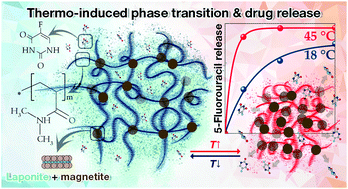Thermoresponsive hydrogels physically crosslinked with magnetically modified LAPONITE® nanoparticles†
Abstract
Recently, considering the potential applications of hydrogel nanocomposites in biomedical engineering, there has been a growing interest in the synthesis of hydrogels with improved mechanical properties. Among magnetic materials, iron oxides are of particular interest due to their magnetic properties and biocompatibility. At the same time, LAPONITE®, a synthetic clay, can be used to improve the mechanical properties of polymer-based nanocomposites. In this study we report the effects of hydrogel composition and structure on its thermoresponsive properties and hydrogel sorption and release of a model anticancer drug – 5-fluorouracil. Using one-step coprecipitation method we synthesized magnetic LAPONITE® (LAM) nanoparticles with magnetite-to-LAPONITE® weight ratios from 2 : 1 to 1 : 8. With increase in magnetite concentration the ferrofluidic properties of LAM nanoparticles are getting improved, while fluorouracil absorptivity – decreases. Exfoliation of the clay is observed when the magnetite content exceeds the LAPONITE® content. Physical crosslinking of poly(N-isopropylacrylamide) with LAM nanoparticles yields magnetic thermosensitive hydrogel nanocomposites with controllable temperature-induced drug release. All hydrogel nanocomposites have a distinct volume phase transition from a swollen state to a collapsed state upon heating within the physiologically acceptable temperature range of 33–36 °C.



 Please wait while we load your content...
Please wait while we load your content...